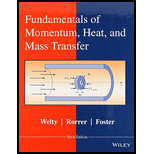
Concept explainers
Interpretation:
The number of molecules which crosses the circular hole is to be determined.
Concept Introduction:
The formula to calculate number of molecules
that crosses a unit area per unit time in only one direction is:
Here,
The formula to calculate the speed of sound
in a perfect gas is:
Here,
Answer to Problem 1.1P
Explanation of Solution
Given information:
The gas is at standard conditions with
The diameter of the circular hole is,
Assume that the perfect gas is air with the value of
Use equation (2) to calculate the speed of sound in perfect gas as:
Since,
Thus,
It is given that the sound speed in the perfect gas is nearly equal to the average molecular velocity.
Thus,
Area of the circular hole is calculated as:
Equation (1) gives the number of molecules that crosses a unit area per unit time in one direction. To calculate the number of molecules that crosses a particular area per unit time, multiply equation (1) by A as:
Thus, the number of molecules which crosses the given circular hole is,
Want to see more full solutions like this?
Chapter 1 Solutions
Fundamentals of Momentum, Heat, and Mass Transfer
 Introduction to Chemical Engineering Thermodynami...Chemical EngineeringISBN:9781259696527Author:J.M. Smith Termodinamica en ingenieria quimica, Hendrick C Van Ness, Michael Abbott, Mark SwihartPublisher:McGraw-Hill Education
Introduction to Chemical Engineering Thermodynami...Chemical EngineeringISBN:9781259696527Author:J.M. Smith Termodinamica en ingenieria quimica, Hendrick C Van Ness, Michael Abbott, Mark SwihartPublisher:McGraw-Hill Education Elementary Principles of Chemical Processes, Bind...Chemical EngineeringISBN:9781118431221Author:Richard M. Felder, Ronald W. Rousseau, Lisa G. BullardPublisher:WILEY
Elementary Principles of Chemical Processes, Bind...Chemical EngineeringISBN:9781118431221Author:Richard M. Felder, Ronald W. Rousseau, Lisa G. BullardPublisher:WILEY Elements of Chemical Reaction Engineering (5th Ed...Chemical EngineeringISBN:9780133887518Author:H. Scott FoglerPublisher:Prentice Hall
Elements of Chemical Reaction Engineering (5th Ed...Chemical EngineeringISBN:9780133887518Author:H. Scott FoglerPublisher:Prentice Hall
 Industrial Plastics: Theory and ApplicationsChemical EngineeringISBN:9781285061238Author:Lokensgard, ErikPublisher:Delmar Cengage Learning
Industrial Plastics: Theory and ApplicationsChemical EngineeringISBN:9781285061238Author:Lokensgard, ErikPublisher:Delmar Cengage Learning Unit Operations of Chemical EngineeringChemical EngineeringISBN:9780072848236Author:Warren McCabe, Julian C. Smith, Peter HarriottPublisher:McGraw-Hill Companies, The
Unit Operations of Chemical EngineeringChemical EngineeringISBN:9780072848236Author:Warren McCabe, Julian C. Smith, Peter HarriottPublisher:McGraw-Hill Companies, The





